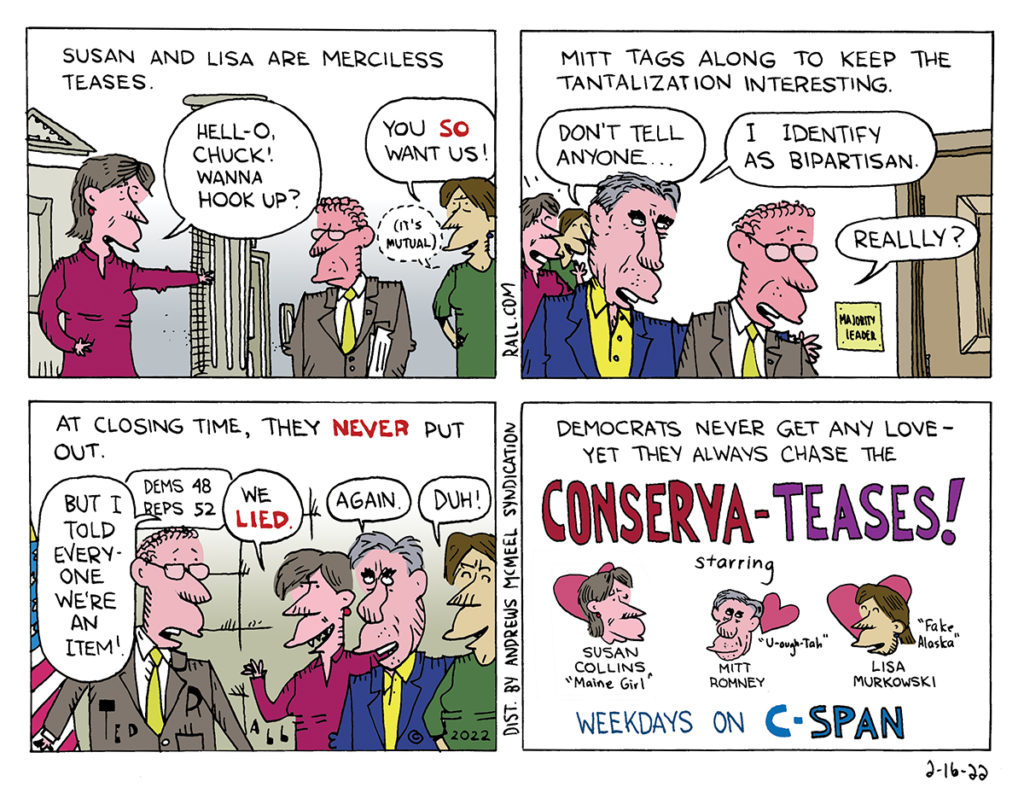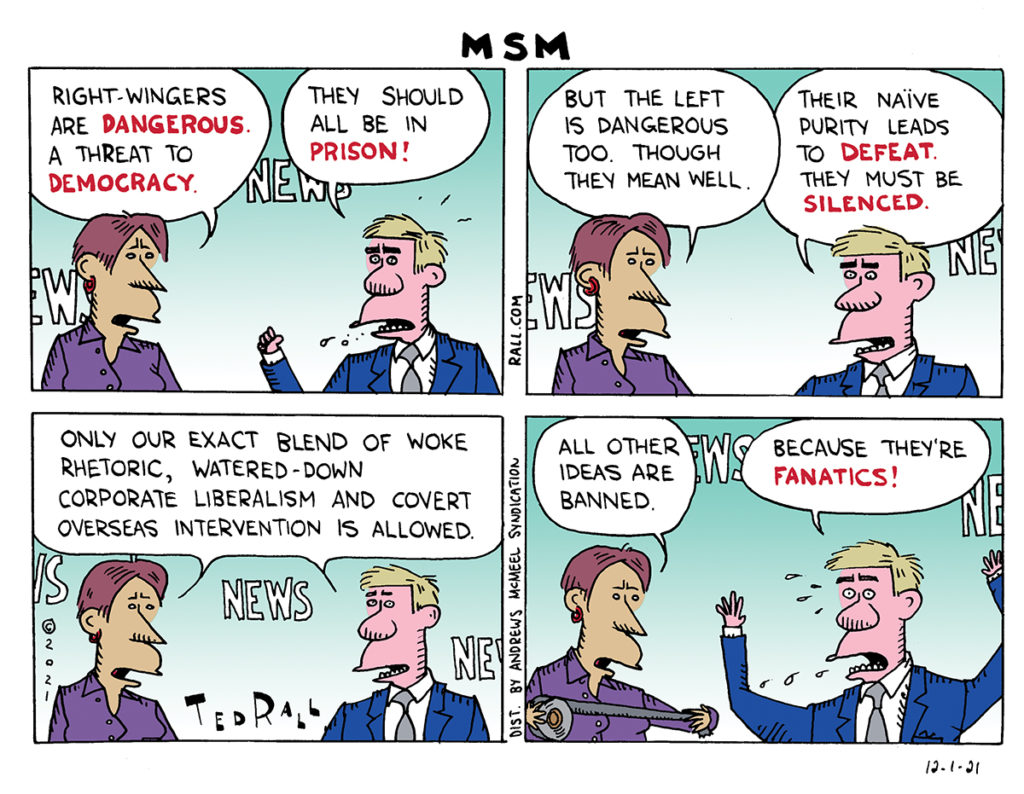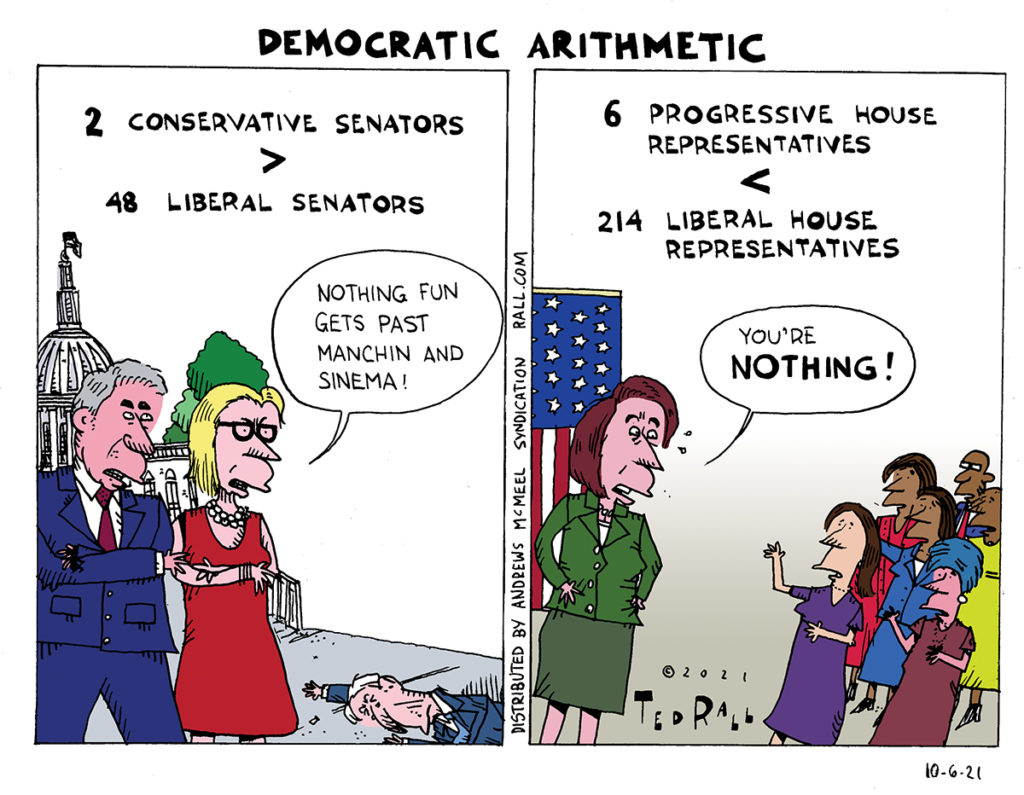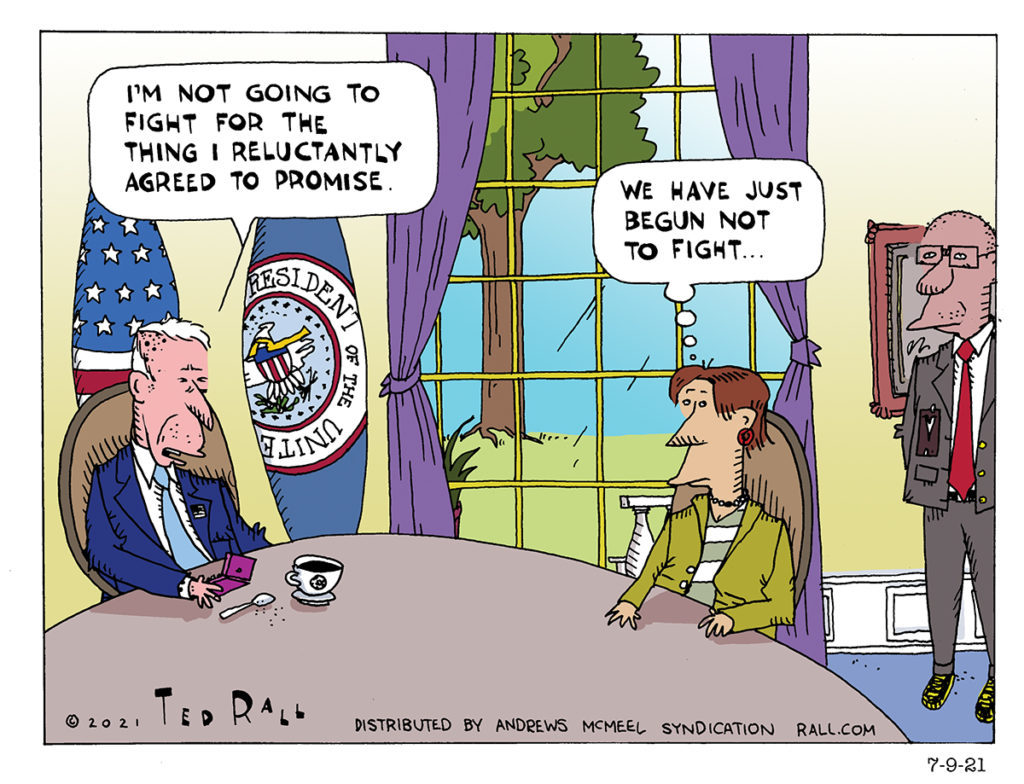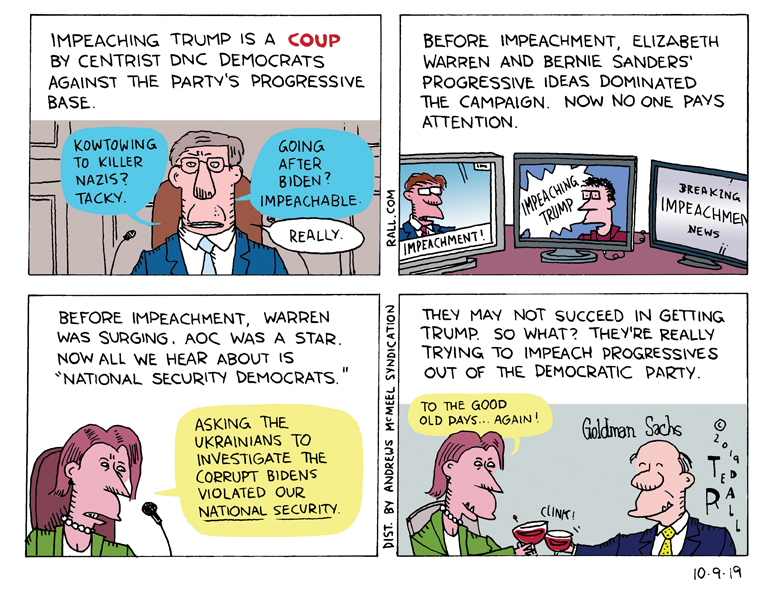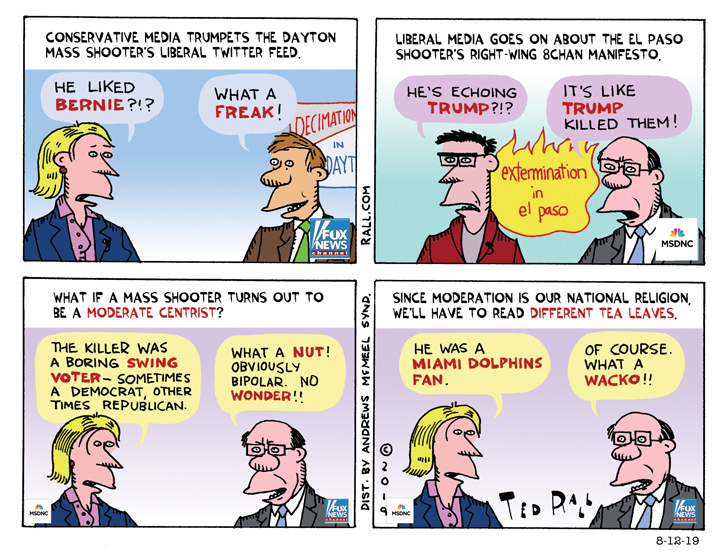Whether it’s build back better or a Supreme Court confirmation fight, there’s a certain set of Republicans in the Senate around Lisa Murkowski, Mitt Romney and Susan Collins who always tease the Democratic counterparts and the media that they might vote Democratic, but they never do.
MSM
Political centrists, including those who run the mainstream corporate media, position themselves as reasonable and more rational than proponents of ideas to their left or to the right. But the militant moderates are fanatics in their own right, closed to any possibility that they might be mistaken and willing to ruthlessly crush opposing views.
Democratic Moderates Aren’t the Answer to Right-Wing Republicanism. They’re the Cause.
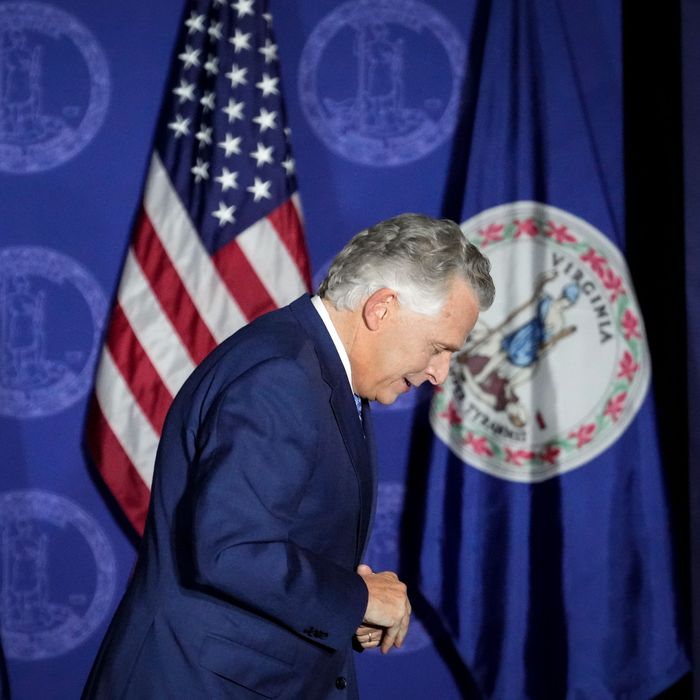
Another election, another shellacking. Democrats are returning to the political reality that predated the quantum singularity of Biden’s anti-Trump coalition: adrift, ideologically divided and, as always, arguing over whether to chase swing voters or work hard to energize their progressive left base.
At the root of the Democrats’ problem is rightward drift. The 50-yard line of American politics has moved so far right that Richard Nixon would be considered a liberal Democrat today. How did we get here? In part it’s due to the moderates who control the party leadership—not just because they don’t fight for liberal values hard enough (though that’s true), but because of an intended consequence few people focus upon: their campaigning reinforces the right.
Washington Post columnist Megan McArdle wrote an essay a few weeks ago that’s still rattling around in my brain. It’s about a topic that students of politics often wonder about: what’s the smartest way forward for Democrats?
In general terms, McArdle takes up the mantle of the dominant moderates who argue that the party can’t push for progressive policies, or push for anything at all, unless it holds the reins of power. Win first, improve people’s lives later.
It’s an old position. I’ve countered the wait-for-progress folks by pointing out that later rarely seems to come. When Democrats win, as Barack Obama did in 2009—he won the House and the Senate and even briefly achieved a filibuster-proof 60-vote supermajority—they choose not to go big or push hard for purported liberal goals like increasing the minimum wage, federally legalizing abortion or socializing healthcare. I agree with progressive strategist Anat Shenker-Osorio’s answer to the attentistes: “The job of a good message isn’t to say what’s popular but to make popular what needs to be said.”
In other words, use the bully pulpit. Lead.
Still, I’ve never read or heard the mainstream position articulated quite as clearly as McArdle does. She quotes self-described progressive election analyst David Shor. “To me, Shor’s vision — sort your ideas by popularity, then ‘Start at the top, and work your way down to find something that excites people’ — sounds less inspiring but more likely to help Democrats get and hold power,” McArdle summarizes. “It doesn’t require Democrats to persuade voters that, say, an Asian-American assistant professor has exactly the same interests as a rural, White call-center worker or a Hispanic plumber and that only a conspiracy of the very rich prevents them from realizing it. Democrats merely have to learn what voters already want.”
She attacks “the young idealists who staff campaigns and newsrooms” who “sustain a rarefied bubble where divisive slogans such as ‘defund the police’ can be questioned only with great delicacy, while significantly more popular propositions like ‘use the military to help police quell riots’ cannot be defended at all.” Pointing out that only a third of American voters have a bachelor’s degree, she concludes: “Democrats cannot afford to cater only to that hyper-educated class [of young, urban, educated idealists].”
Leftists can easily agree that ignoring less-educated voters is a prescription for electoral defeat. More importantly, everyone deserves representation—for the Left, “everyone” especially includes the poor and working-class, who are less likely to be highly educated. But her assumption that (for lack of a better word) the underclasses are inherently reactionary, cannot be organized behind a slate of progressive policy goals, and that this state of affairs must be accepted is fundamentally flawed and ideologically self-sabotaging.
We think of pre-election campaigning, the election and post-election governing as discrete phases. Actually, they’re highly intertwined. For example, political campaigning is itself a self-reinforcing mechanism that affects not merely a race’s outcome but the ideological reality under which the winner must govern.
Democrats, McArdle says, must win first before they can improve things. But what’s the point of winning if you go to make things worse?
The above presents a classic example of single-mindedly seeking Pyrrhic victory at the polls. If Democrats abandon “defend the police” in favor of “use the military to help police quell riots” as per McArdle’s counsel, they might win more elections. But to what end? Victorious law-and-order Democrats will further militarize policing, increase shootings and beatings of civilians and hasten creeping authoritarianism. “Defund the police” is a tone-deaf slogan but the idea of shifting resources away from violence-based law enforcement into programs that reduce crime by strengthening communities is a good one. We need a better slogan, not armed goons on city streets.
Bill Clinton won twice but his signature legislation—welfare reform, NAFTA-GATT and the crime bill—were right-wing wish-list items that could have just as easily been signed into law by George W. Bush. With Democrats like that, who needs Republicans?
You can win with a political bait-and-switch. Joe Biden did. He ran as Not Trump, the ultimate centrist compromiser who bragged that he was friends with every Republican senator, even the racist ones. But you can’t govern after you pull one off. Biden’s attempt to pass infrastructure and social spending bills are being shredded by centrists who point out that he didn’t run on policies inspired by Bernie Sanders. I love those policies. But where’s the electoral mandate for these changes?
More subtly but I think more importantly, running right is a lose-lose proposition. If you win, you can’t pass the progressive agenda you claim to really want. If you lose, you’ve validated and endorsed hardline Republicans. Win or lose, polls should provide prompts for smarter messaging and framing, not selling out. A party that claims to represent the left has to run to the left.
(Ted Rall (Twitter: @tedrall), the political cartoonist, columnist and graphic novelist, is the author of a new graphic novel about a journalist gone bad, “The Stringer.” Order one today. You can support Ted’s hard-hitting political cartoons and columns and see his work first by sponsoring his work on Patreon.)
Democratic Arithmetic
Democrats are fighting internally between their progressive and centrist wings over infrastructure bills, one for actual buildings, the other one for actual human beings. Interestingly, two right wing senators control what comes out of the US Senate even though they are only a tiny minority. Over in the House of Representatives, on the other hand, the small minority progressive squad is dismissed as the small minority that they are. What both assumptions have in common is that right wing politics are always considered normative.
It’s Not That Biden Is Too Slow. It’s That He’s Going Too Small.

In the intraparty Democratic war between progressive leftists and corporate centrists, each side speaks a different language. The two factions’ takes on Joe Biden’s first weeks as president starkly demonstrate that inability to communicate.
Biden’s base is his centrist supporters, those who backed him against Bernie Sanders during the primaries on the grounds that his moderate demeanor and years of wheeling and dealing would allow him to find common ground with Republicans who would probably continue to control the Senate. Centrists’ response to criticism of Biden is that Donald Trump’s mishandling of the coronavirus crisis, the shattered economy and the deep wound to our national psyche caused and embodied by the January 6th Capitol insurrection will require a long time to fix. Impatience, they say, is unrealistic and unfair.
The same principle applies to Biden’s response to longer-standing policy issues that predate Trump, like climate change and the healthcare system. They say, he just moved into the White House. Chill.
But progressives aren’t complaining that Biden is too slow—although they obviously feel a sense of urgency. They are complaining that his policy prescriptions are too small.
Biden came out of the gate fast with dozens of executive orders. But policy-obsessed progressive populists weren’t impressed by their close-to-nonexistent impact.
On January 22nd the president issued a mandate that federal workers become subject to a $15-an-hour minimum wage. Given that the “Fight for $15” movement began in 2012, satisfying that progressive demand would require $17 after adjusting for inflation. More vexing is that Biden’s order doesn’t do anything. According to the U.S. Office of Personnel Management fewer than 20,000 of the nation’s 2.1 million federal government employees—fewer than one percent—currently earn less than $15 an hour. The administration made a splash but 99% of federal workers won’t see an extra penny.
Biden claims that he wants to reform American prisons, an idea for which progressives have been fighting and where common ground with Republicans may be achievable. But his executive order, which tells the Department of Justice not to renew contracts with privately-operated, for-profit prisons, affects only 14,000 out of nearly 152,000 federal inmates currently incarcerated, or fewer than 10% of federal prisoners. There were 1.8 million people in American prisons as of the middle of last year. Biden’s executive order will lead to the transfers of fewer than 1% of the total prison population.
“When it comes to private prisons, the impact of this order is going to be slight to none,” Fordham law professor John Pfaff tells NBC News. Because it fools us into believing in a nonexistent improvement it might even make things worse. “The symbolism carries the very real risk of making us blind to the nearly identical incentives of the public prison sector, and the public side is so much vaster in scope,” Pfaff warns.
One Biden order promises to replace the federal government fleet of 645,000 vehicles with electric ones. The catch is, he doesn’t say when. Unless it happens before 2035 and no future administration issues another executive order reversing this one, companies like General Motors will render the issue moot. The automaker has announced that it will stop making gas-powered passenger cars and SUVs that year.
I was pleasantly surprised by Biden’s decision to push his $1.9 trillion COVID-19 stimulus package through Congress using the budget reconciliation process, which only requires 50 votes rather than a 60-vote supermajority in the Senate. Democrats finally seem to be waking up to the reality that Republicans really, really hate them and aren’t going to cooperate with their initiatives. But here’s the thing: neither the one-time $1400 per person payout nor the $15/hour minimum wage can lift us out of the deep coronavirus depression. The American workforce has lost at least 10 million jobs over the last year. Millions of people face eviction or foreclosure. There is widespread consensus among economists that Biden’s plan, assuming it passes intact, is insufficient and will fail to provide long-lasting relief.
If Biden has big plans in mind, now—while Democrats control the Senate and he enjoys high approval ratings—is the time to tee them up.
First, the president should communicate to the public that sizable coronavirus relief packages will be an ongoing part of fiscal policy until the pandemic is over, recovery is at hand and the rising tide has already begun to lift most boats. The current ad hoc approach inherited from Trump is woefully inadequate and creates unnecessary anxiety among individuals and in the securities markets. Stimulus in fits and starts doesn’t work. We need a Universal Basic Income.
Second is the environment. Long neglected by both major parties, the climate change crisis represents both an enormous opportunity as well as an existential threat to humanity. Auto manufacturers that are rapidly moving toward electric vehicles and big energy companies that already understand the future lies outside fossil fuels prove that the marketplace is ahead of government when it comes to the Green New Deal. Biden deserves credit for talking about the problem but he wants to do way too little way too late.
He should work to push through a comprehensive plan to radically reduce the emission of greenhouse gases within the next few months.
There are, of course, a myriad of other policy challenges ahead—militarism, immigration, an increasingly authoritarian Silicon Valley—but if I were Biden I would tackle racism and particularly racist policing quickly. American police are vicious, stupid and predatory. They make communities more dangerous, not safer. Cops should get out of the revenue enhancement business. Protecting the public must take priority over protecting themselves. Harassing people based on ethnicity and other demographic profiles must end. Biden can use the threat of withholding federal funding to force states and cities to reinvent policing from the ground up.
We want Biden to be fast. More than that, though, we want him to be bold.
(Ted Rall (Twitter: @tedrall), the political cartoonist, columnist and graphic novelist, is the author of “Political Suicide: The Fight for the Soul of the Democratic Party.” You can support Ted’s hard-hitting political cartoons and columns and see his work first by sponsoring his work on Patreon.)
Joe Biden Will Be a Republican President
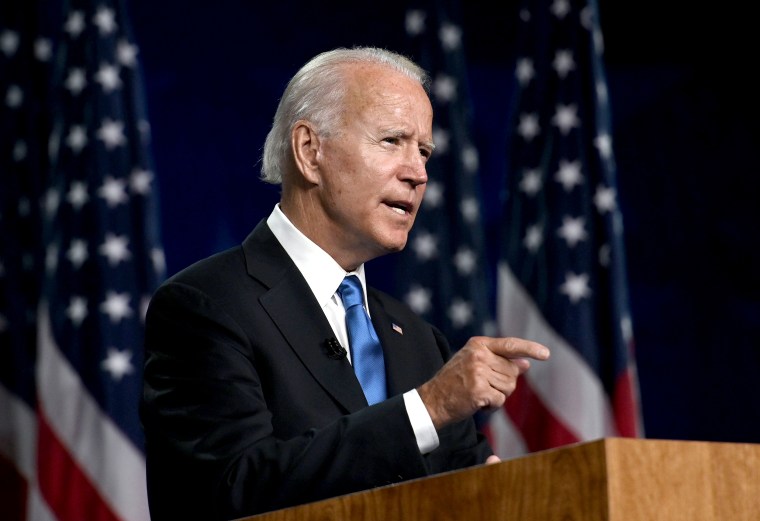
Past performance is no guarantee of future returns but there are few more reliable ways to predict what comes next than to examine the historical record because, most of the time, history really does repeat.
What kind of president would Joe Biden be? His centrist supporters assure progressives that he will be one of them, pushing an aggressive legislative agenda reminiscent of FDR’s New Deal. His Republican opponents portray him as a socialist. But Biden hasn’t actually promised anything ambitious.
The last two Democratic presidencies provide a good indication of what a Biden Administration would look like. Like Biden, Bill Clinton and Barack Obama hail from the centrist party establishment. If personnel is policy, the three men hang out with many of the same advisors, businesspeople and elected officials. They’re not identical: Clinton is a charismatic retail politician, Obama is aloof and professorial, and Biden is an LBJ-style buttonholer minus Johnson’s secret idealism. But they’re ideologically and temperamentally similar to a remarkable extent.
I remembered Clinton and Obama as deeply disappointing to voters with traditional liberal Democratic values. I remembered that most of their major legislative accomplishments would not have been out of place under a Republican administration.
When I checked the historical record recently, however, it was even worse than I remembered.
Clinton used his political capital to push through free trade deals like NAFTA and the WTO, which killed manufacturing jobs and drove the final nails into the coffin of big labor. He “ended welfare as we know it,” making it even more difficult for people who lost their jobs to get back on their feet and adding the chronically poor to the ranks of the homeless. Clinton signed Joe Biden’s now infamous 1994 crime bill into law, codifying a racist judicial system that disproportionately punishes black men for relatively minor offenses.
Clinton repealed the 1930s-era Glass-Steagall Act, banking deregulation set the stage for banks to wallow in the reckless predatory lending practices that tanked the global economy in 2008-09.
His most impressive achievement was balancing the federal budget and paying off the deficit, but he didn’t do it by raising taxes on the rich. He imposed austerity on social programs—just like a Republican would do.
I searched hard for Clintonian achievements that could credibly be called liberal or at least left of center, but aside from a few minor regulations here and there, there aren’t any. “So we liberals and radicals searched the Clinton administration for vast new programs to applaud. But nothing loomed into view,” Paul Berman wrote in The New Republic at the end of Clinton’s presidency in 2000. Clinton was a moderate Republican president.
In some ways—especially foreign policy—Obama was even worse. Clinton bombed with the bloody relentlessness of a Reagan or a Bush: Bosnia, Sudan, Afghanistan and, forgotten now, Iraq so much and so often that pilots dumped their bombs in the desert to cover for the fact that they were running out of fresh targets. His sanctions stopped everything, including medical supplies, from entering Afghanistan. But he had nothing on Obama.
After Col. Muammar Gaddafi signed a peace deal with Bush that ended Libya’s nuclear program, Obama assassinated him with a drone, plunging that nation into a bloody civil war. Thanks to Obama, Libya, formerly the most literate and prosperous country in Africa, is now a failed state where slavery has been restored. Obama similarly wrecked Syria, where he also funded and armed jihadi extremists against secular socialist leaders. Obama radically expanded Bush’s drone program, kept Gitmo open, effectively pardoned Bush’s torturers, expanded the USA-Patriot Act and NSA spying on your phone calls and emails.
With Democrats like these, you don’t need Republicans!
For liberals, there is one relatively bright spot in these 16 years of Democratic rule: the Affordable Care Act. Obamacare was the first major health-sector reform in decades and brought coverage to tens of millions of patients, most beneficially via Medicaid expansion.
Let’s face it. The last two Democratic presidents didn’t really govern like Democrats. Compare the ACA to the achievements of Republican presidents like Ronald Reagan, George W. Bush and Donald Trump. Republicans push through huge changes when they are in office.
And I’m not even going to point out—well, yes I am—that Obamacare was conceived by the right-wing Heritage Foundation.
As I wrote at the beginning of this essay, what happened under Clinton and Obama won’t necessarily be replicated by Joe Biden. But it almost certainly will be.
There’s a reason Biden considered picking a Republican running mate and a reason Republicans are endorsing him and a reason he gave Republicans more speaking time at the Democratic National Convention than AOC—he’s one of them, not one of us.
(Ted Rall (Twitter: @tedrall), the political cartoonist, columnist and graphic novelist, is the author of the biography “Political Suicide: The Fight for the Soul of the Democratic Party.” You can support Ted’s hard-hitting political cartoons and columns and see his work first by sponsoring his work on Patreon.)
Don’t Worry, Centrists. Bernie Isn’t Radical.

Watching panicky corporate-owned Democrats twist on the devil’s fork of Bernie Sanders’ “political revolution” is almost as much fun as it must have been for my mom and her fellow villagers to watch Vichy collaborators and Nazi sympathizers being executed by the resistance at the end of World War II. (That, Chris Matthews, is how you do a Nazi-to-2020 metaphor.)
Centrist/moderate/Third Way Dems are afraid of Bernie, not because he would lose to Trump or inverse-coattail down-ballot candidates, but because they would lose their longstanding minority control of the party apparatus. After the convention in Milwaukee, for example, the nominee gets to choose the new DNC chairman. Sanders will not keep Tom Perez.
Electability, however, is the moderates’ supposed chief concern. And enough moderate Democratic voters are buying it to make it A Thing.
Don’t worry, centrists. The data is clear. As they did throughout 2016, head-to-head matching polls show Bernie defeating Trump by a comfortable margin.
More to the point, you can’t trust corporate media outlets that describe Sanders’ policy agenda as radical or extreme. I wish he were! He’s a classic liberal Democrat, not as ambitious as FDR or LBJ, more like Humphrey or Mondale.
And that’s just on domestic economic issues. On foreign policy, Bernie Sanders is no progressive. In fact, he is to the right of where the Republican Party was before Ronald Reagan.
He acknowledges it was a mistake but he voted for George W. Bush’s 2001 invasion of Afghanistan. He voted several times in favor of funding the Afghanistan and Iraq wars. He favors military interventions like those against Syria and Libya, albeit in a limited fashion. He is less critical of Israel than most progressives. He is OK with drone assassinations.
Sanders is basically George W. Bush plus deadlines minus the invasion of Iraq. No real “socialist” shares his views. Socialists, democratic or otherwise, are anti-interventionist. So why are centrists so freaked out?
The answer, obviously, is his domestic platform. But even that is relatively moderate if you take a hard look at it.
Bernie Sanders wants to raise the federal hourly minimum wage to $15. That movement goes back at least to a strike by fast-food workers in 2012. Seven big states and several major cities including New York and San Francisco, have already instituted $15.
Over the last eight years, of course, inflation has eaten away at the value of those $15. Meanwhile, corporate profits have risen. And it would be at least another year until a President Sanders could theoretically sign a bill. At the official, ridiculously understated-from-reality inflation rate, $15 in 2012 will be equivalent to $17 in 2021. If the inflation rate were still calculated the same way as a few decades ago, the minimum wage would be at least $25 in order to be worth the same as it was in 1970. If it were up to me, I’d start the discussion at $50.
Looking at it from a historical vantage point, Bernie’s proposal is too little, too late for workers. It isn’t radical and it won’t tank the economy—New York and San Francisco are proof of that.
Sanders wants to forgive all $1.6 trillion of student loan debt and make college tuition and fees free at public four-year colleges and universities. Let’s take those two ideas one at a time.
Financial aid budget cuts, soaring tuition and high interest rates have made student loan debt explode. In 1999 it totaled $90 billion—adjusted for inflation, 8.7% of the current total. In 1986 it was $10 billion—and that’s after the Reagan Revolution replaced almost all student grants with loans.
Restoring student debt to 1999 levels would require forgiving 91.3% of today’s total. Bernie wants 100%. Not a huge difference. And it would stimulate the economy by freeing up young adults to buy houses and cars. But the banks sure would miss “their” profits.
Bernie’s tuition plan only covers 70% of college students; those in private institutions would receive nothing. Tuition and fees only account for 39% of expenses for the average public college student living on campus. So Bernie would pick up the tab for 27.3% of total expenses for American college students at four-year schools.
Actually, it’s not even that much. Kids whose parents earn a total of $125,000 a year would get nothing. That eliminates 12% of students. Total cost to taxpayers would be $48 billion a year. A sizable sum to be sure, but less impressive/scary than you might think. Here’s another way to think about it: it’s the same as occupying 2.3 Afghanistans at once. We can easily afford to get closer to “richer” countries that offer completely free college—tuition, fees, housing, books, everything—economic dynamos like Turkey, Uruguay, Slovenia, Morocco, Malaysia, Brazil and Kenya.
Medicare For All is as close as the senator from Vermont comes to pushing a radical agenda. But that’s only by narrow American standards. Compared to other countries, MFA would be a relatively modest affair. It wouldn’t come close to what the rest of the world expects government to supply in terms of healthcare. Like, I just got a mysterious surprise bill for $1,800. Description: “lab test.” What lab test? It was June. I don’t remember. And I’m insured.
First, the cost: $34 trillion over 10 years. But Americans would have a net savings because healthcare costs here are even higher than that: $36 trillion over 10 years. Net savings: $2 trillion over 10 years. What Sanders does not talk about, and would need to be addressed, is how to deal with the insurance company employees who would be laid off. Job retraining would be needed for them as well as previously displaced workers.
Denmark, Britain and Germany are among the countries that have systems more or less similar to MFA. No one is suggesting that their governments are “radical.”
Finally, there’s the Green New Deal. Sanders wants to abolish fossil fuels in the U.S. within 10 years. He’d spend trillions to accomplish that. But consider the alternative: mass extinction. Not doing it is the wild-and-crazy option.
To recap: love, hate or be indifferent to Bernie Sanders, that’s up to you. But moderates shouldn’t fear him because he’s a radical. Radicals shouldn’t love him because he’s one of us.
He’s really not.
(Ted Rall (Twitter: @tedrall), the political cartoonist, columnist and graphic novelist, is the author of the forthcoming “Political Suicide: The Fight for the Soul of the Democratic Party.” You can support Ted’s hard-hitting political cartoons and columns and see his work first by sponsoring his work on Patreon.)
The Impeachment of Trump is a Coup d’Etat by DNC Centrists Again
Democrats would like to think that they are all united around the goal of impeaching Donald Trump. But when you scratch the surface what you find is that the impeachment of Donald Trump is less about getting rid of a sitting president and more about regaining control of the Democratic Party from the insurgent progressives who have taken it over since Bernie Sanders.
Can We Blame Moderate Politics for the Next Mass Shooting?
Every time there’s a mass shooting, partisan members of the media scour social media and public postings to see if the perpetrator had a political agenda that they can blame as extremist and therefore responsible for the latest massacre. What’s going to happen when they find that the killer is a boring centrist moderate swing voter?

